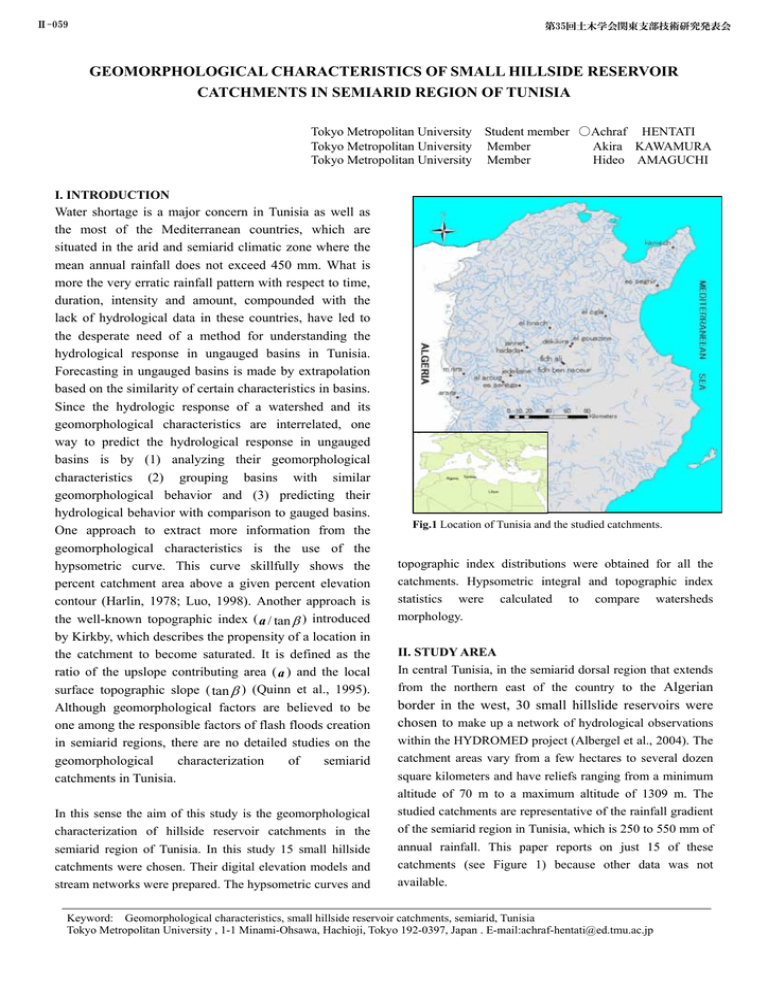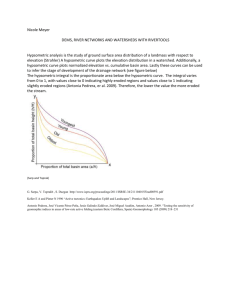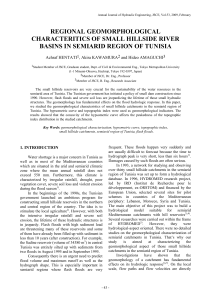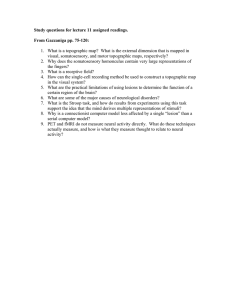GEOMORPHOLOGICAL CHARACTERISTICS OF SMALL HILLSIDE RESERVOIR
advertisement

Ⅱ-059 第35回土木学会関東支部技術研究発表会 GEOMORPHOLOGICAL CHARACTERISTICS OF SMALL HILLSIDE RESERVOIR CATCHMENTS IN SEMIARID REGION OF TUNISIA Tokyo Metropolitan University Student member ○Achraf HENTATI Tokyo Metropolitan University Member Akira KAWAMURA Tokyo Metropolitan University Member Hideo AMAGUCHI I. INTRODUCTION Water shortage is a major concern in Tunisia as well as the most of the Mediterranean countries, which are situated in the arid and semiarid climatic zone where the mean annual rainfall does not exceed 450 mm. What is more the very erratic rainfall pattern with respect to time, duration, intensity and amount, compounded with the lack of hydrological data in these countries, have led to the desperate need of a method for understanding the hydrological response in ungauged basins in Tunisia. Forecasting in ungauged basins is made by extrapolation based on the similarity of certain characteristics in basins. Since the hydrologic response of a watershed and its geomorphological characteristics are interrelated, one way to predict the hydrological response in ungauged basins is by (1) analyzing their geomorphological characteristics (2) grouping basins with similar geomorphological behavior and (3) predicting their hydrological behavior with comparison to gauged basins. One approach to extract more information from the geomorphological characteristics is the use of the hypsometric curve. This curve skillfully shows the percent catchment area above a given percent elevation contour (Harlin, 1978; Luo, 1998). Another approach is the well-known topographic index ( a / tan β ) introduced by Kirkby, which describes the propensity of a location in the catchment to become saturated. It is defined as the ratio of the upslope contributing area ( a ) and the local surface topographic slope ( tan β ) (Quinn et al., 1995). Although geomorphological factors are believed to be one among the responsible factors of flash floods creation in semiarid regions, there are no detailed studies on the geomorphological characterization of semiarid catchments in Tunisia. In this sense the aim of this study is the geomorphological characterization of hillside reservoir catchments in the semiarid region of Tunisia. In this study 15 small hillside catchments were chosen. Their digital elevation models and stream networks were prepared. The hypsometric curves and Fig.1 Location of Tunisia and the studied catchments. topographic index distributions were obtained for all the catchments. Hypsometric integral and topographic index statistics were calculated to compare watersheds morphology. II. STUDY AREA In central Tunisia, in the semiarid dorsal region that extends from the northern east of the country to the Algerian border in the west, 30 small hillslide reservoirs were chosen to make up a network of hydrological observations within the HYDROMED project (Albergel et al., 2004). The catchment areas vary from a few hectares to several dozen square kilometers and have reliefs ranging from a minimum altitude of 70 m to a maximum altitude of 1309 m. The studied catchments are representative of the rainfall gradient of the semiarid region in Tunisia, which is 250 to 550 mm of annual rainfall. This paper reports on just 15 of these catchments (see Figure 1) because other data was not available. Keyword: Geomorphological characteristics, small hillside reservoir catchments, semiarid, Tunisia Tokyo Metropolitan University , 1-1 Minami-Ohsawa, Hachioji, Tokyo 192-0397, Japan . E-mail:achraf-hentati@ed.tmu.ac.jp Ⅱ-059 第35回土木学会関東支部技術研究発表会 Fig.2 Hypsometric curves of the 15 studied catchments. III. METHEDOLOGY Our 15 watershed DEMs come from the Shuttle Radar Topographic Mission (SRTM) data that is available as 100 m resolution DEMs. Once imported in Arcgis, the DEMs are compiled into a DEM mosaic covering Tunisia area. This mosaic DEM is projected to Carthage-UTM-Zone 32N. The DEMs of the studied sites were clipped out from the mosaic DEM. The hypsometric curves of the catchments were obtained. The hypsometric integrals (area under a hypsometric curve) were computed. Also a total of 15 topographic index distribution maps were generated and some statistics such as the mean the median, standard deviation were calculated to compare the topographic index distributions. IV. RESULTS AND DISCUSSION From a visual comparison we can divide the hypsometric curves into three groups as shown in figure 2 with 3 different colors. The first group in red line includes the concave hypsometric curves which have small hypsometric integral. This low hypsometry is due to the low rock resistance to erosion in these watersheds (Harlin, 1978). Those watersheds are likely the most eroded. In the second group, the hypsometric integrals are smaller. In those catchments, the streams are less developed therefore the total amount of the mass removed by the river process is less than in the first group. The third group of watersheds has intermediate hypsometric curves between the first and second group. In figure 3, the topographic index distributions of the 15 watersheds are drawn with same colors as the figure 2. For all the 15 watersheds, the topographic index distributions are positively skewed (see figure 3). We noticed that in the first group (red line) the topographic index distributions are more shifted to the right than the other distributions because those watersheds are flattened by erosion as aforementioned. This is intuitive since in flat regions, we tend to have larger contributing Fig.3 The Topographic index distributions for the 15studied watersheds. areas and smaller slopes giving rise to large topographic index values. As for the second group of watersheds in blue line (figure 3), the stream networks are less developed which give less contributing areas and the slopes are steeper. Consequently, the topographic index values are lower. V. CONCLUSION In this paper, we have characterized the geomorphology of small hillside reservoir catchments in the semiarid region of Tunisia by the use of the hypsometric curve and the topographic index as geomorphic indicators. Findings have shown that hypsometric curves of those watersheds can be classified into three groups. The most eroded watersheds have concave hypsometric curves with small hypsometric integral and as we expected and high frequency of topographic index values showing more contributing areas to excess-saturation runoff. At the contrary, the second group of catchments has convex hypsometric curves and higher hypsometric integrals. They have steeper slopes and less contributing upslope areas. In this case, lower topographic index values are more frequent. The third group is intermediate. REFERENCES Albergel, J., Nasri S., Boufaroua, M., Droubi, A., Merzouk, A. A. 2004: Rain water harvesting and management of small dams in Mediterranean areas (North Africa and Middle East), Conference in Ohrid, FY Republic of Macedonia, 25-29, 1-12, May 2004. Harlin, J.: Statistical moments of the hypsometric curve and its density function, Mathematical Geology, Vol.10, No.1, 59-72, 1978. Luo, W.: Hypsometric analysis with a geographic information system, Computers and Geosciences, Vol. 24, No.8, 815-821, 1998. Quinn, P.F., Beven, K. J. and Lamb, R.: The ln (a/tanβ) index: How to use it within the TOPMODEL framework. Hydrological Processes, Vol.9, 161-182, 1995.



